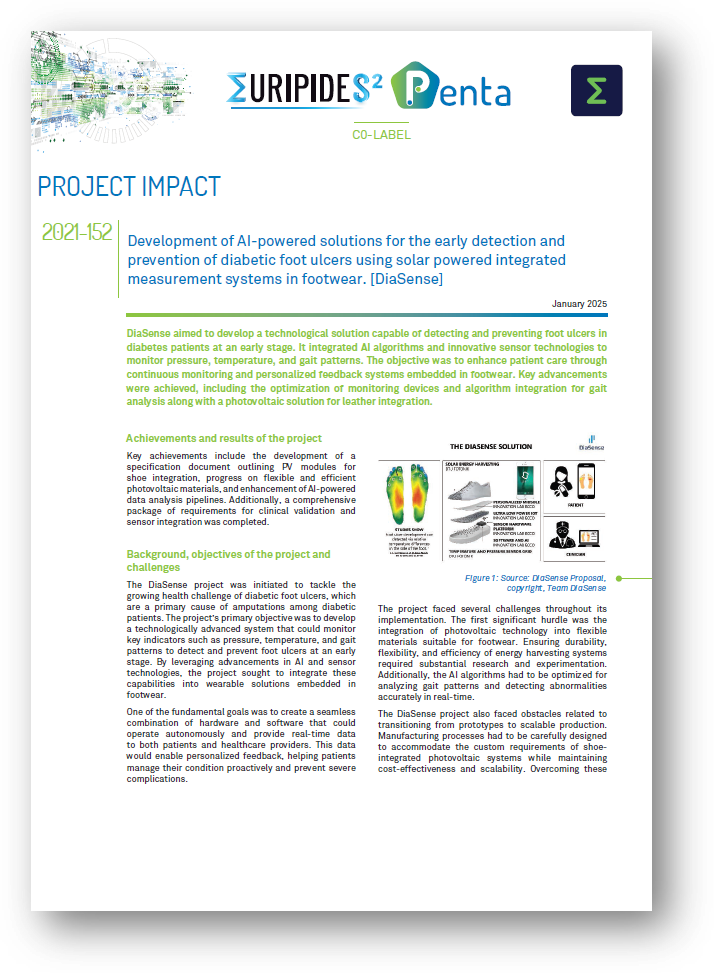Call :
AI Call 2021
Project status :
Running
Key application areas
 Health and Wellbeing
Health and Wellbeing
PARTNER
Amsterdam University Medical Centers / DTU Electro / ECCO Innovation Lab / ECCO Leather BV / MCROBERTS B.V. / SHFT / Technical University of Denmark
Amsterdam University Medical Centers / DTU Electro / ECCO Innovation Lab / ECCO Leather BV / MCROBERTS B.V. / SHFT / Technical University of Denmark
Countries involved
 Netherlands
Netherlands  Denmark
Denmark Project leader(s)
Jeremy MartinKey project dates
01 January 2022 - 30 June 2024Development of AI-powered solutions for the early detection and prevention of diabetic foot ulcers using solar powered integrated measurement systems in footwear. [DiaSense]
DiaSense aimed to develop a technological solution capable of detecting and preventing foot ulcers in diabetes patients at an early stage. It integrated AI algorithms and innovative sensor technologies to monitor pressure, temperature, and gait patterns. The objective was to enhance patient care through continuous monitoring and personalized feedback systems embedded in footwear. Key advancements were achieved, including the optimization of monitoring devices and algorithm integration for gait analysis along with a photovoltaic solution for leather integration.
Achievements and results of the project
Key achievements include the development of a specification document outlining PV modules for shoe integration, progress on flexible and efficient photovoltaic materials, and enhancement of AI-powered data analysis pipelines. Additionally, a comprehensive package of requirements for clinical validation andsensor integration was completed.
Background, objectives of the project and challenges
The DiaSense project was initiated to tackle the growing health challenge of diabetic foot ulcers, which are a primary cause of amputations among diabetic patients. The project’s primary objective was to develop a technologically advanced system that could monitor key indicators such as pressure, temperature, and gait patterns to detect and prevent foot ulcers at an early stage. By leveraging advancements in AI and sensor technologies, the project sought to integrate these capabilities into wearable solutions embedded in footwear.
One of the fundamental goals was to create a seamless combination of hardware and software that could operate autonomously and provide real-time data to both patients and healthcare providers. This data would enable personalized feedback, helping patients manage their condition proactively and prevent severe complications.
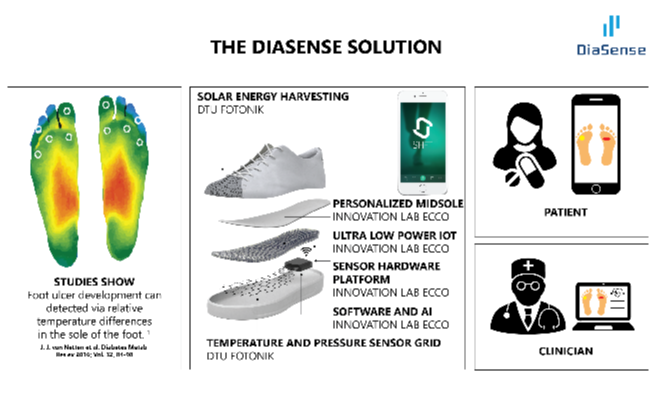
The project faced several challenges throughout its implementation. The first significant hurdle was the integration of photovoltaic technology into flexible materials suitable for footwear. Ensuring durability, flexibility, and efficiency of energy harvesting systems required substantial research and experimentation. Additionally, the AI algorithms had to be optimized for
analyzing gait patterns and detecting abnormalities accurately in real-time. The DiaSense project also faced obstacles related to transitioning from prototypes to scalable production.
Manufacturing processes had to be carefully designed to accommodate the custom requirements of shoeintegrated photovoltaic systems while maintaining cost-effectiveness and scalability. Overcoming these technical and logistical challenges was critical for ensuring the long-term feasibility of the proposed solutions. One of the next steps will be clinical validation.
Technological achievements
The DiaSense project delivered several innovative technological breakthroughs that represent significant progress in wearable health monitoring systems. One of the key achievements was the development of a flexible photovoltaic energy harvesting system based on silicon solar cell beads. This technology provided a lightweight, durable, and efficient power source,
enabling continuous monitoring without reliance on external power supplies. The photovoltaic modules were integrated into shoe materials, specifically targeting areas such as the toe-cap to maximize exposure to sunlight and optimize energy capture.
In addition to energy harvesting, the project achieved remarkable advancements in sensor integration. Pressure and temperature sensors were embedded seamlessly into footwear, ensuring accurate and realtime monitoring of foot conditions. These sensors were coupled with AI-powered algorithms capable of analyzing gait patterns, identifying abnormalities, and
predicting potential risks associated with diabetic foot ulcers. The AI models leveraged advanced machine learning techniques to process data collected from the sensors, enabling proactive interventions and personalized feedback for patients. A significant technological highlight was the development of the DiaSense mobile application. The app acts as the central interface for users, providing real-time data visualizations, temperature and pressure heat maps, and alerts for potential issues such as high pressure or elevated temperature. It includes features like personalized walking plans generated by the AI coach to promote activity and improve blood sugar control. The app’s interactive design supports users by tracking daily steps, walking speed, and distance walked, offering detailed statistics and progress reports. Integrated notifications keep users informed of their foot health status and provide reminders to wear their smart shoes consistently. Future upgrades include compatibility with wearable devices such as Apple Watch, enabling users to monitor their health without relying solely on a smartphone interface. Another major technological achievement was the integration of Mobilise-D algorithms into the MoveMonitor platform, which provided enhanced capabilities for gait analysis. This system allowed for precise measurements of walking behavior, including speed, symmetry, and energy expenditure. The software pipeline was further optimized to support automated data processing and visualization, facilitating ease of use for both patients and clinicians. The technological framework developed during the project laid the foundation for future advancements. These achievements highlight the consortium’s ability to address critical technical challenges and provide scalable solutions for healthcare monitoring. The results indicate strong potential for commercialization, particularly in wearable health monitoring markets, and offer pathways for further research and development to
refine and validate the system.
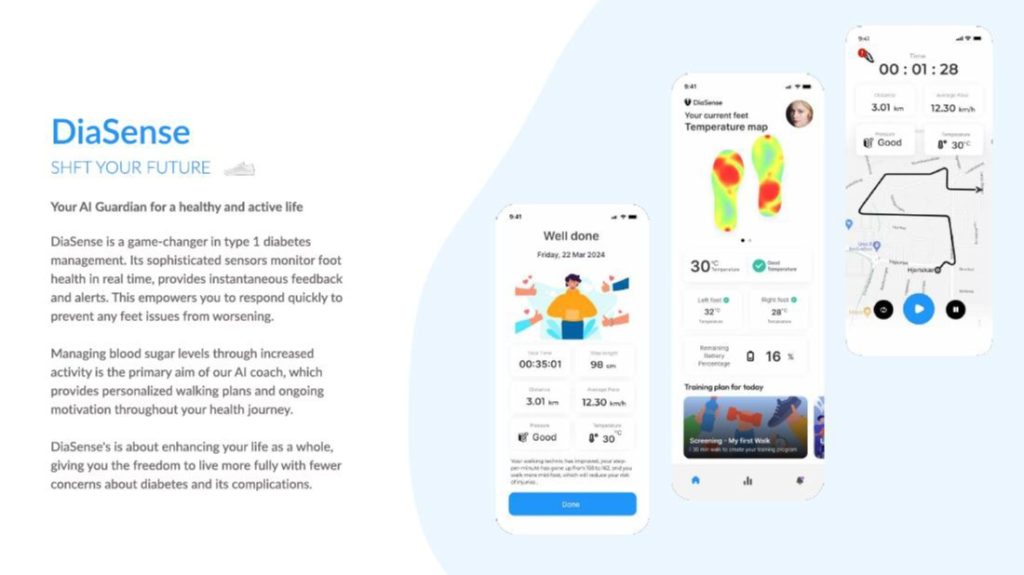
Graphics created and copyrighted by SHFT.
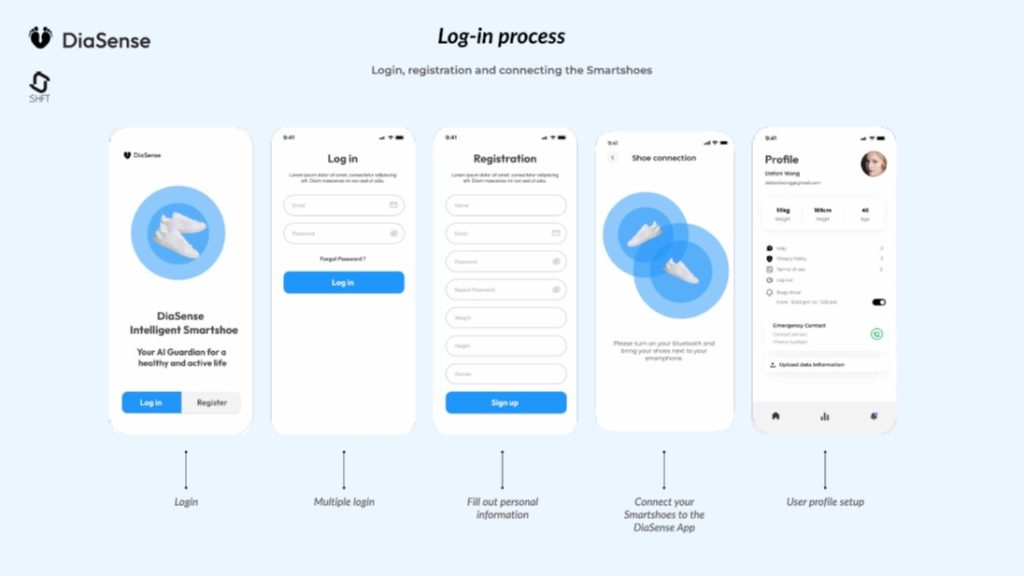
Graphics created and copyrighted by SHFT.
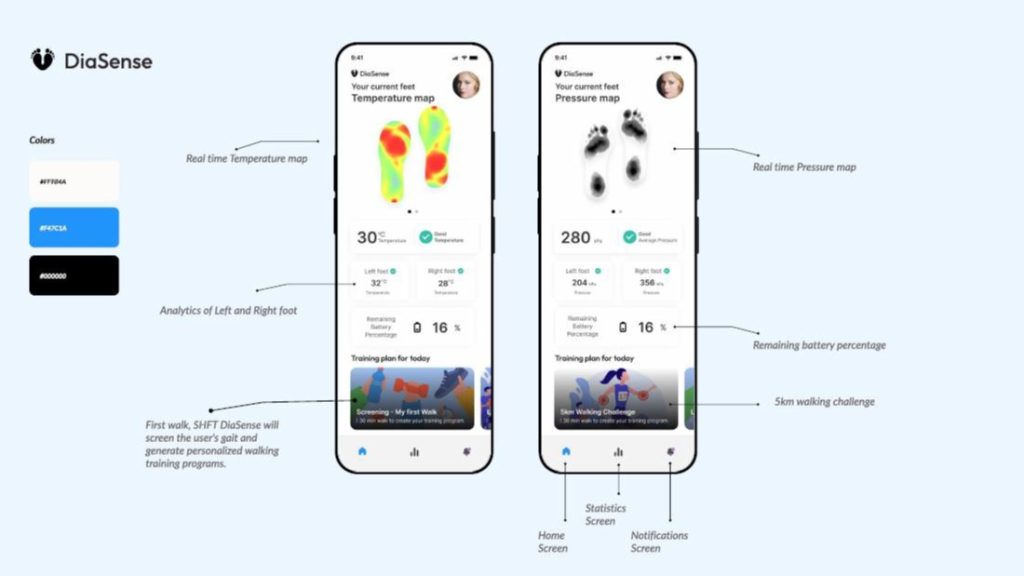
Graphics created and copyrighted by SHFT.
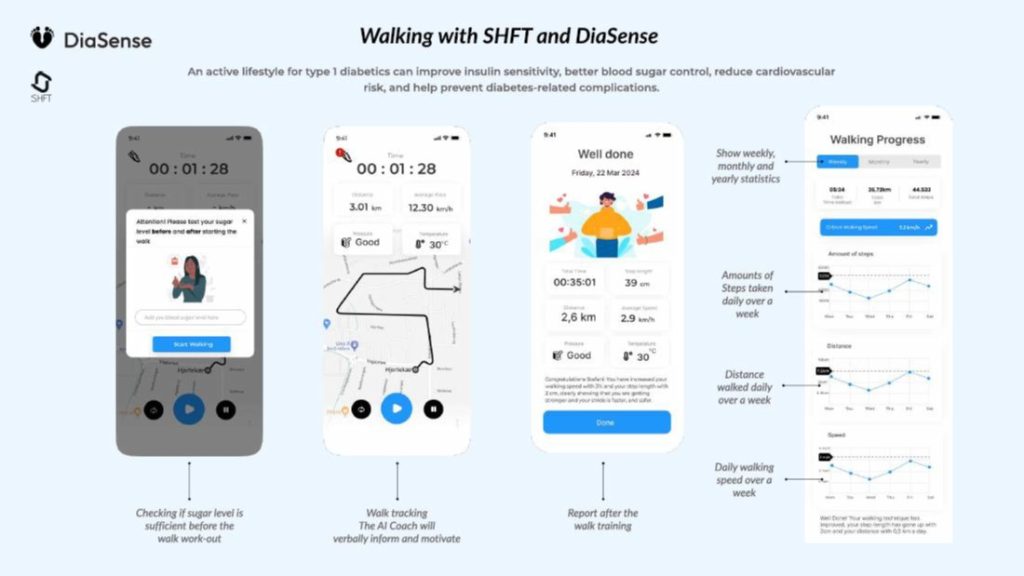
DiaSense. Graphics created and copyrighted by SHFT.
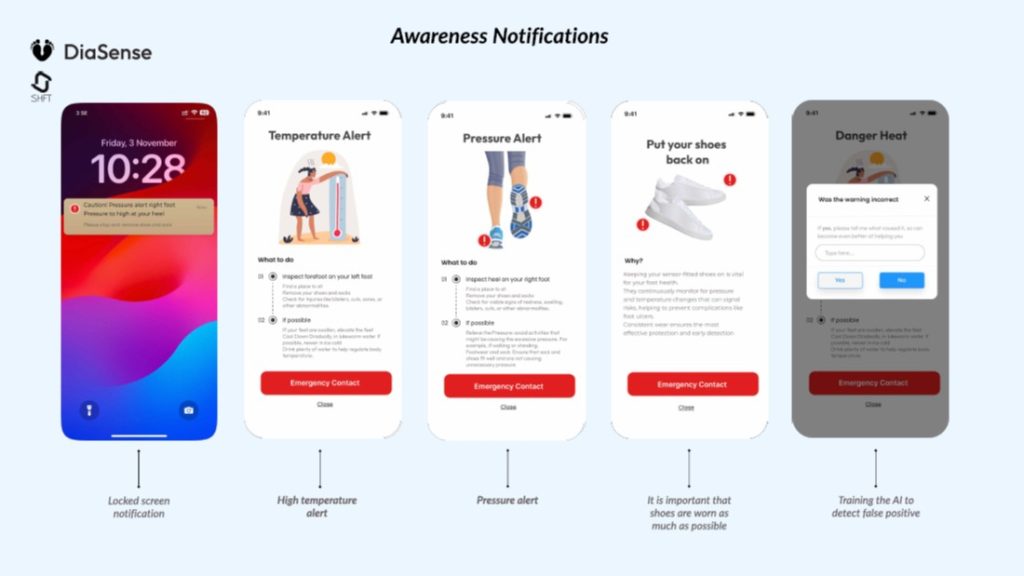
Graphics created and copyrighted by SHFT.
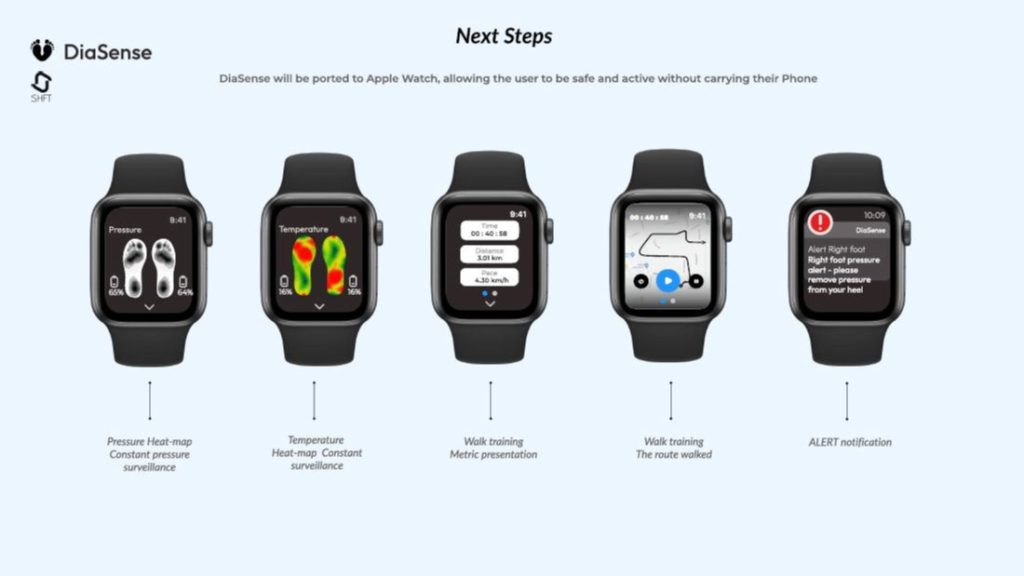
smart watch. Graphics created and copyrighted by SHFT.
Market Potential
The project targeted the diabetic care market, where advanced monitoring systems are in high demand. The estimated growth for wearable health monitoring devices underscores the commercial viability of the DiaSense system. Potential partnerships with medical device manufacturers and healthcare providers can drive adoption and market penetration. Future
commercialization opportunities include expanding into markets requiring gait and activity monitoring beyond diabetic care.
Societal & Economic Impact
The project demonstrated notable societal, environmental, and economic impacts. From a societal perspective, it improved the quality of life for diabetic patients through proactive care and early intervention, potentially reducing amputations and hospitalizations. Environmentally, the integration of renewable energy sources such as solar cells into wearables promoted
sustainability. Economically, long-term cost savings in healthcare are anticipated due to prevention-focused monitoring systems.
Future Developments
Future development efforts will focus on refining flexible PV modules to improve efficiency and reliability. Collaboration opportunities with partners like Exeger present possibilities for commercial deployment. The transition from prototypes to scalable manufacturing is a key target, enabling broader integration of the technology into wearable devices. Follow-up projects will prioritize clinical validation and explore applications in other healthcare monitoring systems to expand the utility of the developed technology.


